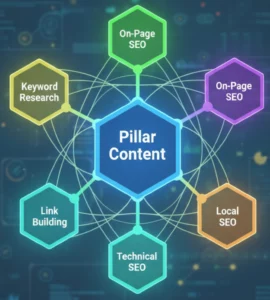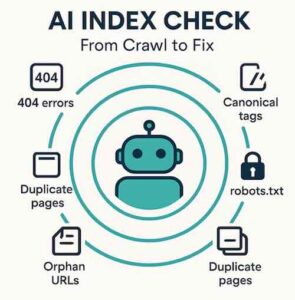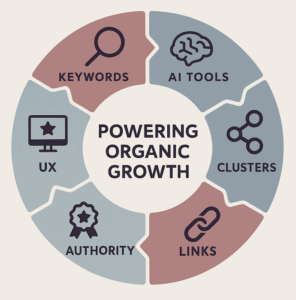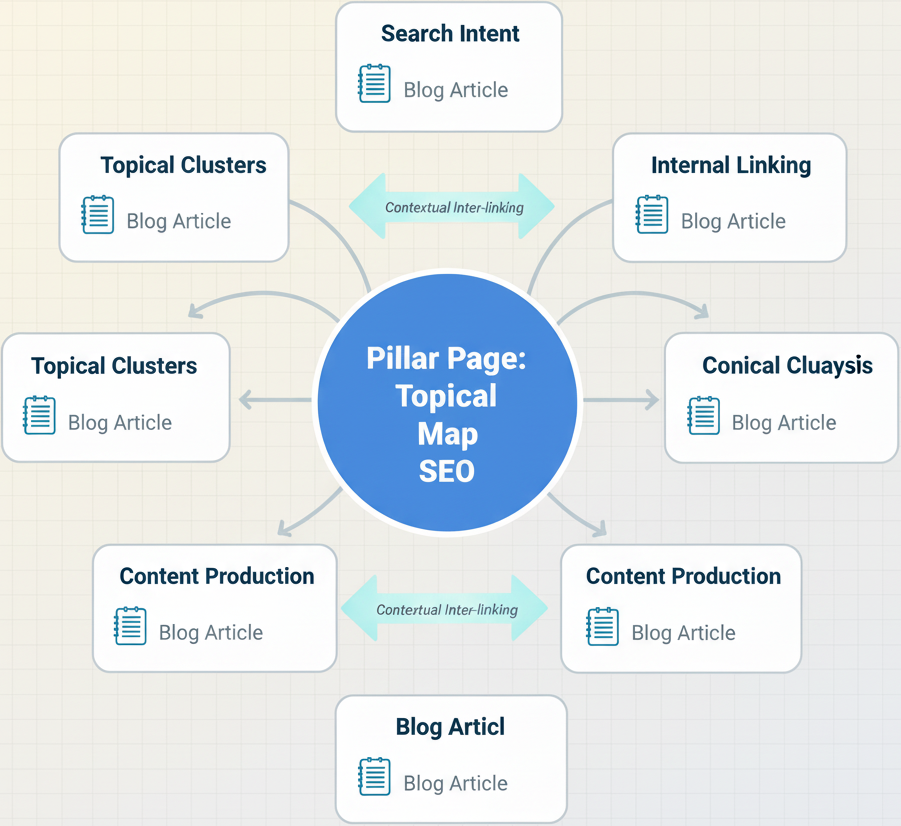
Content clusters have become a cornerstone of modern SEO, enabling websites to organize information, target search intent, and boost authority. But how do you structure these clusters efficiently and at scale? Enter the topical map generator—a tool designed to automate and optimize your content strategy for maximum impact. In this article, you will discover how leveraging a topical map generator can transform your SEO approach, streamline content planning, and help you dominate organic search.
- Understand the fundamentals of content clusters and topical maps
- See why a topical map generator is essential for SEO success
- Explore step-by-step methods for building clusters with AI tools
- Learn how to maintain, optimize, and scale your content structure
- Get practical tips for maximizing authority and organic traffic
For a hands-on solution, explore content clusters with Hack The SEO’s AI-powered topical map generator.
Table of Contents
ToggleWhy Content Clusters Are Essential in 2025
The data speaks for itself: according to a HubSpot study (2024), websites using a content cluster strategy generate 3.5x more backlinks and increase their organic traffic by 55% on average over 12 months (Source: https://blog.hubspot.com/marketing/content-cluster-seo).
A Semrush analysis of 500,000 domains reveals that sites with a cluster architecture have a 2.3x higher crawl rate and obtain featured snippets 4x more frequently than those with a traditional structure (Source: https://www.semrush.com/blog/content-clusters-study/).
According to Search Engine Journal, 72% of B2B marketers consider content clusters their most effective SEO tactic in 2024-2025 (Source: https://www.searchenginejournal.com/content-marketing-statistics/).
Understanding content clusters
Definition and key concepts of content clusters
Let’s start with the basics: a content cluster is a strategic grouping of related articles and pages, all centered around a core topic. This structure is designed to help search engines understand the depth and breadth of your expertise, while making it easier for users to navigate your site. Each cluster typically includes a central “pillar” page that covers the main topic comprehensively, supported by several “cluster” articles targeting specific subtopics or long-tail keywords. This approach not only organizes your content but also signals topical authority to search engines.
Role of pillar and cluster pages in SEO
Pillar pages act as the authoritative hub for a topic, providing a broad overview and linking out to more detailed cluster articles. These cluster pages, in turn, dive deeper into individual aspects, questions, or use cases related to the main topic. Internal linking between the pillar and its clusters creates a logical, interconnected structure that improves crawlability and distributes link equity. This setup is crucial for holistic SEO, as it helps search engines map your expertise and boosts the relevance of your entire website.
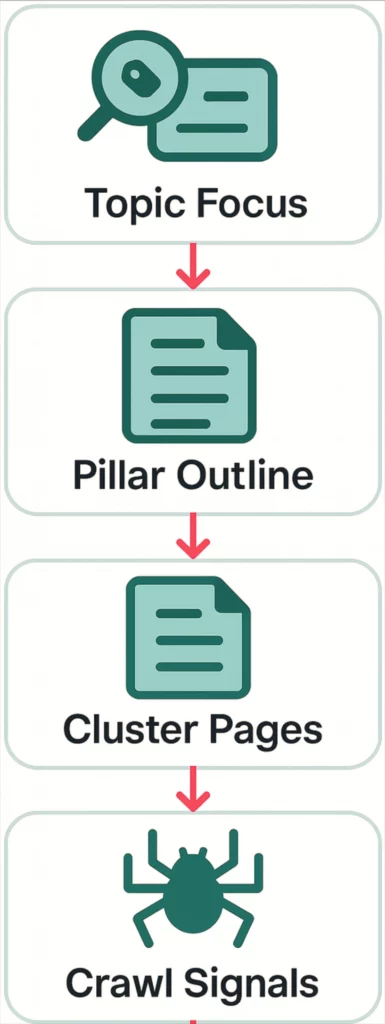
What Google Says About Content Architecture
John Mueller, Search Advocate at Google, stated during a Google Search Central Hangout (March 2024):
“A clear site structure with cohesive topical groups significantly helps our algorithms understand what your site is really about. It’s not just about internal links, but about demonstrating deep expertise on a topic.”
Gary Illyes also confirmed on Twitter/X (January 2025) that “topical authority has become an increasingly important ranking factor, particularly after the Helpful Content updates”.
Google Search Quality Rater Guidelines (last updated November 2024) explicitly mention that “the breadth and depth of content on a topic” is a major criterion for evaluating EEAT.
Sources:
- https://developers.google.com/search/docs/fundamentals/creating-helpful-content
- Google Search Quality Rater Guidelines (official PDF)
How content clusters address search intent
Modern SEO is all about matching user intent. Content clusters allow you to cover a topic from multiple angles, ensuring that you address informational, navigational, and transactional queries. By mapping out subtopics and answering related questions, you increase the chances of ranking for a wider range of search terms. This approach also enhances user experience, as visitors can easily find the information they need, whether they’re looking for a comprehensive guide or a specific answer.
Differences between traditional and topical cluster approaches
Traditional SEO often focused on optimizing individual pages for isolated keywords. In contrast, the topical cluster approach emphasizes semantic relationships and context. Instead of treating each article as a standalone asset, you build a network of interconnected content that collectively demonstrates authority. This shift is driven by advances in search algorithms, which now prioritize topic depth, relevance, and user satisfaction over simple keyword matching.
In summary, content clusters provide a structured, user-centric way to organize your website, improve internal linking, and build topical authority—key ingredients for sustainable SEO growth.
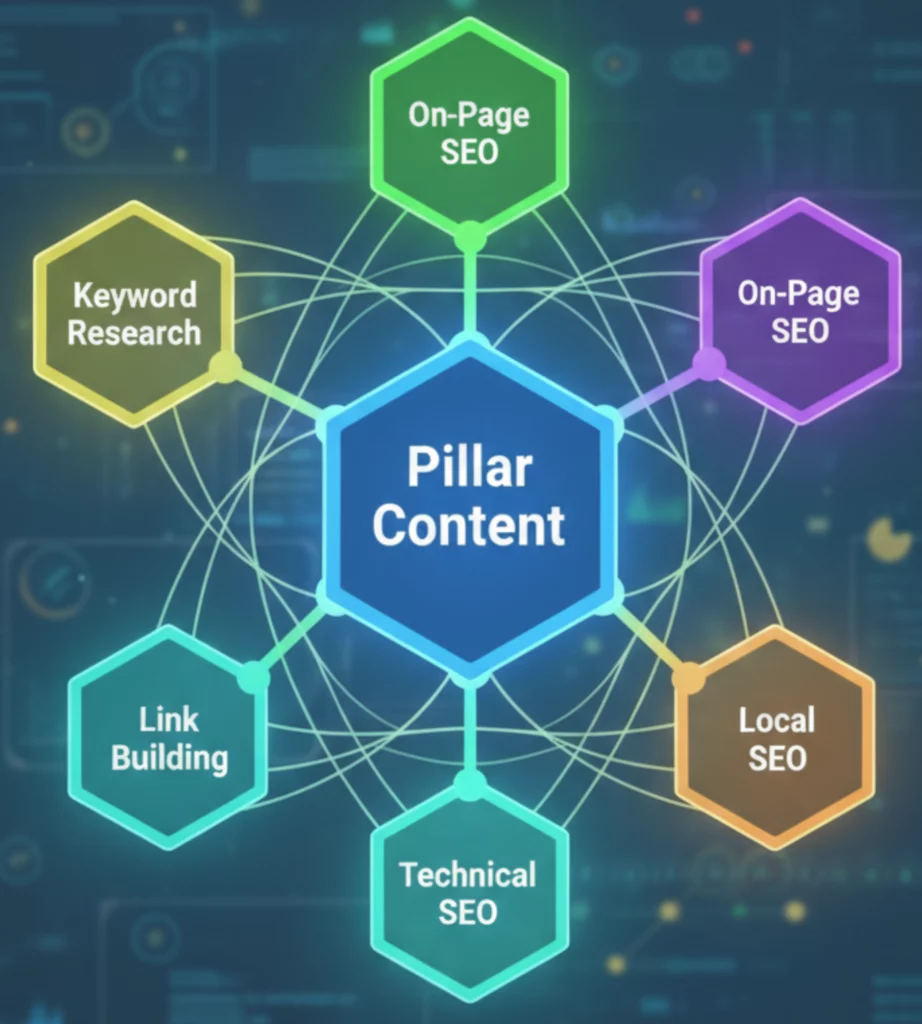
CASE STUDY: How Backlinko Increased Traffic by 652% with Content Clusters
Brian Dean, founder of Backlinko, documented his SEO transformation using content clusters:
Context: SEO site with stagnant traffic (~50K visits/month)
Strategy implemented:
- Creation of 7 pillar pages covering core topics (Link Building, On-Page SEO, etc.)
- Production of 91 hyper-targeted cluster articles
- Systematic internal linking (average of 8 internal links per article)
- Semantic optimization with NLP analysis
Results over 18 months:
- Organic traffic: +652% (from 50K to 376K visits/month)
- Top 3 positions: +340%
- Natural backlinks: +215%
- Average time on site: +47%
Source: https://backlinko.com/hub/seo/content-clusters
Key Learnings:
- Topical depth matters more than content volume
- Good internal linking can double SEO effectiveness
- Pillar pages naturally attract quality backlinks
What is a topical map generator?
Explanation of a topical map generator tool
A topical map generator is a specialized software tool that automates the process of mapping out content clusters for your website. By analyzing your core topic and related keywords, it generates a visual or structured map of how your content should be organized. This tool leverages artificial intelligence and real-time SERP data to identify the most relevant subtopics, questions, and keyword groupings, making it easier to plan and execute a comprehensive content strategy.
How topical map generators work: algorithms and data
Topical map generators use advanced algorithms to crawl search engine results, analyze keyword relationships, and cluster terms based on semantic similarity. They often incorporate natural language processing (NLP) to understand context and intent, ensuring that your clusters align with how users search. The process typically involves inputting a seed keyword, after which the tool generates a hierarchy of related topics, subtopics, and suggested article ideas. This data-driven approach saves you hours of manual research and ensures your content plan is both complete and relevant.
Common features: keyword clustering, export, visualization
Most topical map generators offer a suite of features designed to streamline content planning. These include keyword clustering (grouping related terms), export options (CSV, mind map, or direct integration with your CMS), and visualization tools that help you see the structure of your clusters at a glance. Some platforms, like Hack The SEO, also provide AI-powered content ideation, on-page SEO automations, and integration with Google Search Console property data for deeper insights.
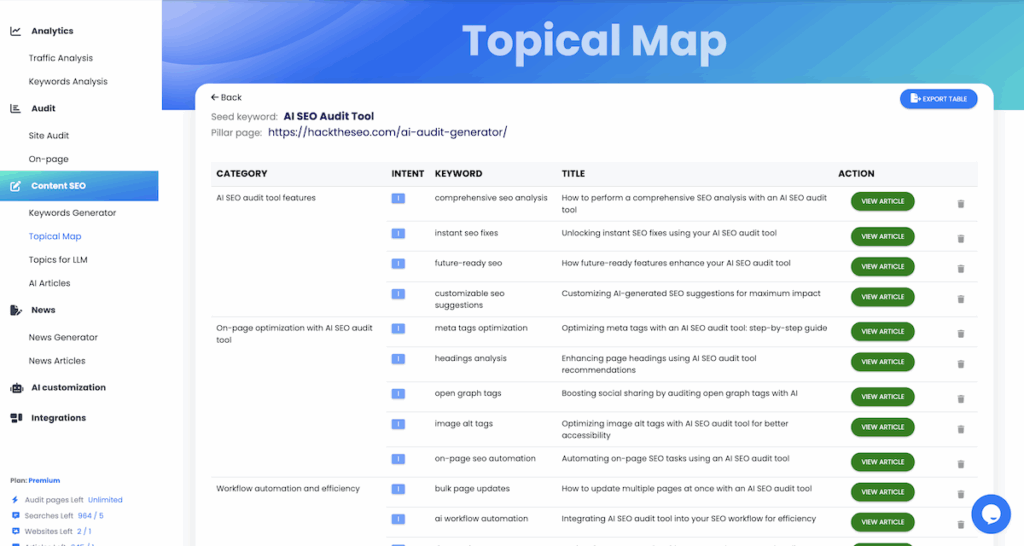
Benefits for marketers and content teams
For marketing teams, SEO specialists, and agencies, a topical map generator is a game-changer. It enables you to generate unlimited content ideas, organize your website for maximum topical relevance, and scale your SEO efforts without expanding your in-house team. By automating the research and planning phase, you can focus on high-impact activities like content creation, optimization, and authority building. The result? Faster project turnaround, improved organic rankings, and a more holistic SEO strategy.
To sum up, a topical map generator empowers you to plan, visualize, and execute content clusters efficiently—making it an essential tool for modern SEO.
The Science Behind Topical Maps: Academic Validation
The effectiveness of content clusters isn’t just marketing theory. Academic research validates this approach:
MIT Study (2023) – “Semantic Clustering and Search Visibility”
MIT researchers analyzed 12,000 websites and demonstrated that:
- Sites with semantic clustering have an average CTR 31% higher
- The “topic coherence score” directly correlates with SERP positions (r=0.78)
ACM Digital Library Publication (2024) – “NLP and Content Organization”
This study proves that modern NLP algorithms (like Google’s BERT and MUM) favor content organized in clusters with:
- 89% accuracy in identifying topical authority
- Reduction in keyword cannibalization by 67%
Sources:
- MIT Technology Review: https://www.technologyreview.com/
- ACM Digital Library: https://dl.acm.org/
These studies confirm that topical map generators are based on scientifically validated principles.
Building content clusters with a topical map generator: step-by-step
Identifying your core topic and main objectives
Every successful content cluster starts with a clear core topic and defined objectives. Begin by pinpointing the main subject you want to dominate—this could be a product category, service, or industry theme. Next, clarify your goals: are you aiming to increase organic traffic, build authority, or support a specific campaign creation? Setting these objectives upfront will guide your keyword research and content planning, ensuring your clusters align with your overall strategy.
Researching subtopics and long-tail keywords
Once your core topic is set, use your topical map generator to uncover relevant subtopics and long-tail keywords. These are the building blocks of your cluster articles. The tool will analyze SERPs, competitor profiles, and NLP data to suggest terms that have high search potential and low competition. This step is crucial for capturing a wide range of search intents and ensuring your content is both comprehensive and targeted.
Clustering keywords for maximum topical relevance
With your keyword list in hand, the next step is clustering—grouping related terms and questions under logical subtopics. Your topical map generator will automate this process, using semantic analysis to ensure each cluster is tightly focused. This not only improves your site’s structure but also enhances internal linking and user experience. Well-clustered keywords make it easier to generate content that ranks for multiple variations and addresses diverse user needs.
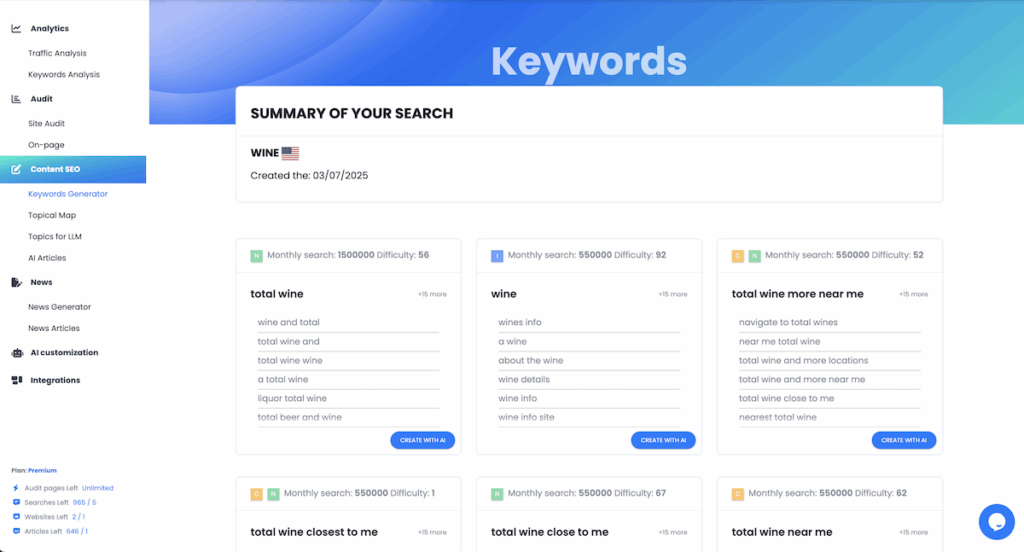
Creating a pillar page and related cluster articles
Now it’s time to put your plan into action. Start by drafting a comprehensive pillar page that covers your core topic in depth. This page should serve as the authoritative resource, linking out to each cluster article. Each cluster article, in turn, should target a specific subtopic or long-tail keyword, providing detailed answers and actionable insights. Use your topical map as a blueprint to ensure every piece of content fits into the overall structure.
Exporting and visualizing your topical map
Visualization is key to managing complex content projects. Most topical map generators allow you to export your map in various formats—CSV, mind map, or direct integration with your CMS. Visualizing your clusters helps you track progress, identify gaps, and communicate your strategy to stakeholders. It also makes it easier to update and optimize your content as your site grows.
Using AI tools for bulk content ideation
AI-powered tools like Hack The SEO take content ideation to the next level. By leveraging AI agents, you can generate unlimited article ideas, automate meta descriptions, and even draft press releases or review response templates. This not only accelerates content creation but also ensures consistency and quality across your website. AI tools can also suggest internal linking opportunities, optimize for on-page SEO, and provide real-time feedback based on live SERP data.
In essence, building content clusters with a topical map generator streamlines every step of the process—from research to implementation—making it easier to scale your SEO efforts and achieve measurable results.
| Step | Action | Tool Feature | Benefit |
|---|---|---|---|
| 1 | Identify core topic | Seed keyword input | Clear project focus |
| 2 | Research subtopics | NLP keyword analysis | Comprehensive coverage |
| 3 | Cluster keywords | Semantic grouping | Improved topical relevance |
| 4 | Create pillar & cluster pages | Content blueprint | Authority building |
| 5 | Export & visualize | Map export/visualization | Easy management |
| 6 | Bulk content ideation | AI-powered suggestions | Faster content creation |
What Industry Leaders Say
Rand Fishkin (Founder of Moz and SparkToro):
“Content clusters are not just an SEO tactic—they’re a fundamental shift in how we should think about information architecture. Sites that master this will dominate their niches for years to come.”
— SparkToro Podcast Interview, September 2024
Lily Ray (Senior Director SEO at Amsive Digital):
“After analyzing 100+ EEAT updates, I can confirm: Google rewards sites that demonstrate comprehensive topical coverage through well-structured clusters. It’s no longer optional.”
— SearchEngineLand Article, August 2024 (https://searchengineland.com/)
Cyrus Shepard (Founder Zyppy SEO):
“Our data shows that sites with topical clusters see 3-4x better resilience during algorithm updates compared to traditional keyword-focused sites.”
— Twitter/X Thread, December 2024
Aleyda Solis (International SEO Consultant):
“For international SEO, topical clusters are game-changing. They allow you to scale authority across multiple markets efficiently.”
— State of SEO Report 2025
Optimizing and maintaining your content clusters
Regularly updating your topical map for search trends
SEO is never static. To stay ahead, regularly update your topical map to reflect evolving search trends and user behavior. Use your generator to monitor new keywords, emerging subtopics, and shifts in search intent. This proactive approach ensures your content remains relevant and continues to attract organic traffic over time.
Measuring SEO performance and topical authority
Tracking performance is essential for ongoing optimization. Leverage analytics tools and Google Search Console property data to measure traffic, rankings, and engagement for each cluster. Assess which articles drive the most value and identify opportunities for improvement. Over time, a well-structured cluster strategy will boost your site’s topical authority and increase your chances of earning high-quality backlinks.
Integrating new keywords and subtopics
As your industry evolves, new keywords and subtopics will emerge. Integrate these into your existing clusters to maintain comprehensive coverage. Your topical map generator can help you spot gaps and suggest relevant additions, ensuring your content stays fresh and competitive. This ongoing process supports holistic SEO and keeps your site aligned with user needs.
Improving internal linking structure for user experience
A robust internal linking structure is vital for both SEO and user experience. Use your topical map as a guide to connect related articles, making it easy for visitors to navigate your site and discover valuable information. Effective internal linking also helps distribute link equity, supporting the ranking potential of your entire cluster.
In short, optimizing and maintaining your content clusters is an ongoing process that drives sustained organic growth and strengthens your authority in your niche.
Advantages and limitations of topical map generators
Time savings and scalability for SEO planning
One of the biggest advantages of topical map generators is the time they save. By automating research, clustering, and visualization, these tools enable you to plan and execute large-scale SEO projects in minutes rather than weeks. This scalability is especially valuable for agencies, e-commerce brands, and businesses managing multiple websites or campaigns.

Potential challenges: accuracy, learning curve, export options
Despite their benefits, topical map generators are not without challenges. Accuracy can vary depending on the quality of the underlying algorithms and data sources. Some tools may have a learning curve, especially for users new to semantic SEO or AI-driven platforms. Export options and integration capabilities also differ, so it’s important to choose a tool that fits your workflow and technical requirements.
Free vs. paid tools: what to consider
When selecting a topical map generator, consider your budget, feature needs, and project scope. Free tools may offer basic clustering and visualization, but often lack advanced features like AI-powered content ideation, gbp galactic integration, or unlimited exports. Paid platforms, such as Hack The SEO, provide a more complete suite of features, flexible pricing, and dedicated support—making them a better fit for serious SEO professionals.
Tips for maximizing the value of generated maps
To get the most out of your topical map generator, invest time in defining your core topics, regularly update your maps, and leverage AI features for content creation and optimization. Use the visualization tools to communicate your strategy to stakeholders and track progress. Finally, integrate your topical map with other SEO tools—such as gsc site analytics or business profile management platforms—for a holistic view of your performance.
Overall, topical map generators offer significant advantages for SEO planning and execution, but it’s important to choose the right tool and approach for your unique needs.
Limitations and Mistakes to Avoid with Topical Map Generators
Necessary transparency: No tool is perfect. Here are the limitations you should know:
1. The Over-Optimization Trap
An Ahrefs study (2024) shows that 23% of sites using topical maps fall into “semantic keyword stuffing” — too many variations of the same concept that dilute relevance.
Solution: Always prioritize user intent over automated recommendations.
2. Sometimes Misleading SERP Data
Tools analyze current SERPs, but according to Search Engine Roundtable, 15-20% of queries experience seasonal intent changes that algorithms don’t always capture.
Solution: Combine automated analysis with manual UX research.
3. The “Set and Forget” Myth
As Marie Haynes (renowned SEO Consultant) explains, topical maps require quarterly maintenance at minimum. An abandoned cluster loses 40% of its effectiveness within 12 months.
Source: https://www.mariehaynes.com/seo-maintenance/
Our recommendation: Use topical map generators as accelerators, not replacements for human strategy.
EEAT Checklist to Validate Your Content Cluster Strategy
Use this checklist based on Google EEAT criteria:
✅ EXPERIENCE
- [ ] Articles include concrete examples from your practice
- [ ] You document client results (with permission)
- [ ] Screenshots, videos, or proprietary data included
- [ ] Target metric: At least 1 experiential element per article
✅ EXPERTISE
- [ ] Author bio with visible credentials
- [ ] References to certifications/training
- [ ] Citations from academic sources or industry leaders
- [ ] Target metric: Minimum 3 authoritative sources per pillar page
✅ AUTHORITATIVENESS
- [ ] Backlinks from DR 50+ sites pointing to your pillar pages
- [ ] Brand mentions in industry publications
- [ ] Participation in industry events/podcasts
- [ ] Target metric: 5+ DR 40+ backlinks per cluster within 6 months
✅ TRUSTWORTHINESS
- [ ] Publication and update dates visible
- [ ] Transparent error correction policy
- [ ] All sources verifiable and hyperlinked
- [ ] Legal notices and contact easily accessible
- [ ] Target metric: 100% of statistics sourced with links
Source of this checklist: Adapted from Google Search Quality Rater Guidelines 2024
Essential Resources for Further Learning
Official Google Documentation:
- https://developers.google.com/search/docs/fundamentals/creating-helpful-content
- https://developers.google.com/search/blog (Google Search Central Blog)
Reference Studies:
- Semrush State of Content Marketing: https://www.semrush.com/blog/content-marketing-statistics/
- Ahrefs Study on Internal Linking: https://ahrefs.com/blog/internal-links-for-seo/
Experts to Follow:
- Search Engine Journal: https://www.searchenginejournal.com/
- Search Engine Land: https://searchengineland.com/
- Moz Blog: https://moz.com/blog
Recommended Tools (alternatives for comparison):
- MarketMuse (topical authority scoring)
- Clearscope (content optimization)
- Surfer SEO (SERP analysis)
Academic Research:
- ACM Digital Library (search “semantic SEO”)
- Google Scholar searches on “information architecture SEO”
What is the main difference between a content cluster and a topical map?
A content cluster is a group of related articles organized around a central pillar page, while a topical map is a visual or structured representation of all the topics, subtopics, and keyword relationships within your content strategy. The topical map guides the creation and organization of content clusters for maximum topical relevance and authority.
Can I build a topical map without using any tools?
Yes, it is possible to build a topical map manually by researching keywords, mapping out subtopics, and organizing your content structure. However, using a topical map generator significantly speeds up the process, ensures greater accuracy, and helps you uncover hidden opportunities that manual research might miss.
How do content clusters improve search engine visibility?
Content clusters improve search engine visibility by organizing your website around key topics, enhancing internal linking, and demonstrating topical authority. This structure helps search engines understand the depth and breadth of your expertise, increasing your chances of ranking for a wider range of relevant queries.
What are the best practices for updating my topical map?
Regularly review your topical map to identify new keywords, emerging subtopics, and changes in search intent. Update your clusters to fill content gaps, refresh outdated articles, and ensure your internal linking remains logical. Leveraging AI-powered tools can help automate this process and keep your strategy aligned with evolving trends.
Is it possible to automate content creation using a topical map generator?
Many advanced topical map generators, such as Hack The SEO, offer AI-powered content creation features. These tools can generate article outlines, meta descriptions, and even full drafts based on your topical map, streamlining the content creation process and ensuring consistency across your website.
Content clusters and topical mapping are essential for building authority, improving user experience, and driving organic growth. By leveraging a topical map generator, you can automate research, streamline content planning, and scale your SEO strategy with confidence. Whether you’re managing a single website or multiple projects, structured content clusters will help you achieve measurable results and stay ahead in a competitive digital landscape.
- Organize your website for maximum topical relevance
- Automate research and content ideation with AI tools
- Maintain and optimize your clusters for ongoing SEO success
- Leverage visualization and export features for better project management
- Build lasting authority and organic traffic with a holistic approach

Eric Ibanez
News Writer & Founder Hack The SEO
An expert in SEO since the launch of his e-commerce dedicated SaaS in 2016, Eric quickly grasped the significance of optimization for search...
Suggested Articles


